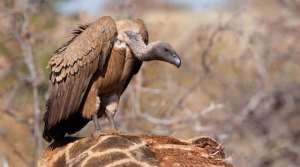
I don’t think a lot of people like the vulture, the fact that it’s an ugly bird, with a long bald neck, grumpy temper and above all feeds on carcasses. However, no matter how we treat them, whatever these birds may seem, their role in nature is very significant.
A vulture is a species of carnivorous and scavenging bird. They look for carcasses that are easily torn or have already been torn to pieces by large scavengers. Without them, mankind may suffer deadly epidemics.
In search of food, vultures travel long distances. Recently, researchers described the route of one of the species of vultures, from its nest in Tanzania, flew for food in Kenya, Sudan and Ethiopia.
Vultures have a unique appearance and generally have a head without feathers or almost without feathers and a large hooked beak. Species in Africa are referred to as Old World vultures and there are 11 species on the continent, of these, six are in danger.
Located at the peak of the tropic chain, the vultures are authentic guardians of nature. With their necrophagous diet, eating dead or decaying animal flesh, they eliminate from the natural environment the threat of diseases and epidemics that may arise from the decay of animal carcasses.
They are therefore essential to keep our environment healthy. Without their recycling action, diseases could also contaminate water sources and involve many living beings. The vultures play their role completely free.
They are also great allies of breeders, not only because they clean up the natural environment, but also they avoid the treatment and incineration of thousands of tons of animal remains every year.
In this way, they allow to save millions in animal waste management, as well as to avoid the emission of one hundred thousand tons of CO2 per year, for the benefit of all. However, the populations of vultures are disappearing at an alarming rate.
Here are some facts:
In the last thirty years, the number of vultures in West Africa has fallen by 95% outside the protected areas. Currently, 75% of all species of vultures are facing extinction in one way or another. Of the 23 species of vultures that exist in the world, as many as 16 are seriously threatened.
During the 1990s, 99% of the four species of vultures became extinct on the Indian continent. Currently, in India, Pakistan, Nepal, and Iran, their decline has come to a halt, but their number is far from that of the past.
In the European Union, more than 95% of European vultures live between Spain, Portugal, and Italy. It is probably the best-preserved vulture’s populations in the world.
At a time when the vultures are already threatened, the governments of Spain, Italy, and Portugal, as well as those responsible for the European Union, must guarantee the health of the necrophagous bird populations that live in their territories.
Diclofenac, a drug for veterinary use is responsible for the extinction of 99% of the vultures in Asia and Europe. It is harmless to humans and livestock to which it is given, but it is lethal to these birds.
However, there are alternatives to Diclofenac, which are harmless to vultures and of similar cost to breeders. Prohibiting the dangerous Diclofenac throughout the world where the number of vultures is reducing is very important.
A bird, which gastric juice is able to destroy bacteria, among which are causative agents of cholera and anthrax, which are deadly for many other species, must be protected.




 Whoever participated in the plunder of the state must be held accountable – Jane...
Whoever participated in the plunder of the state must be held accountable – Jane...
 A vote for John and Jane is a vote to pull Ghana from the precipice of destructi...
A vote for John and Jane is a vote to pull Ghana from the precipice of destructi...
 I’ll repay your abiding confidence with loyalty, understanding and a devotion to...
I’ll repay your abiding confidence with loyalty, understanding and a devotion to...
 ‘I’ve learnt deeply useful lessons for the future' — Serwaa Amihere breaks silen...
‘I’ve learnt deeply useful lessons for the future' — Serwaa Amihere breaks silen...
 I’m sorry for the embarrassment – Serwaa Amihere apologises for leaked sex video
I’m sorry for the embarrassment – Serwaa Amihere apologises for leaked sex video
 Dumsor: Matthew Opoku Prempeh not in charge of Energy sector – Minority
Dumsor: Matthew Opoku Prempeh not in charge of Energy sector – Minority
 Adu Boahen’s murder: Police arrest house help who was in possession of deceased’...
Adu Boahen’s murder: Police arrest house help who was in possession of deceased’...
 Akufo-Addo nominates Felicia Attipoe as Tema West MCE
Akufo-Addo nominates Felicia Attipoe as Tema West MCE
 Election 2024: I can't have someone I defeated twice as my successor – Akufo-Add...
Election 2024: I can't have someone I defeated twice as my successor – Akufo-Add...
